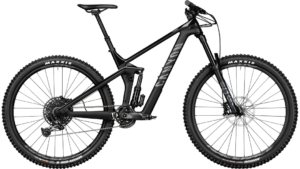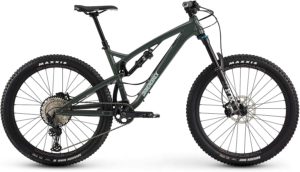Which is Better for Mountain Bicycle – Carbon or Aluminum?
 The choice of frame material is one of the key decisions when buying a mountain bicycle. Over the years, mountain bicycle frames have been made from a variety of materials. Now the main choice is between aluminum and carbon mountain fiber are still common.
The choice of frame material is one of the key decisions when buying a mountain bicycle. Over the years, mountain bicycle frames have been made from a variety of materials. Now the main choice is between aluminum and carbon mountain fiber are still common.
Each frame material has its pros and cons, depending on your priorities as a cyclist, including weight, budget, durability and the characteristics you want from the frame and, by extension, the mountain bike. What are the key properties of aluminum and carbon fiber to consider when buying a mountain bike?
Carbon (carbon fiber)
Carbon fiber is an increasingly popular material for bicycle frames, but it differs significantly from metal tubes for frame construction. Because of the fibrous nature of this material, it has a much more distinct “grain” than metal. A well-designed carbon frame can have a structure lined up to provide maximum strength in the areas of maximum stress.
Do you really need carbon on your bike?
 There is a special attitude towards carbon in the cycling community – some idolize it, while others consider it a trick by cunning marketers. There was a time when any carbon component raised the status of the rider: a bicycle with a carbon frame allowed the owner to look at the other cyclists.
There is a special attitude towards carbon in the cycling community – some idolize it, while others consider it a trick by cunning marketers. There was a time when any carbon component raised the status of the rider: a bicycle with a carbon frame allowed the owner to look at the other cyclists.
What’s more, all it took was a carbon handlebar to feel a fit of acute satisfaction. Clever Chinese quickly recognized the trick and offered the suffering people carbon components in the style “to look, but not to be” – aluminum covered with carbon on top. As a result, the weight and price of such carbon turned out to be more than aluminum. Those were wild times, yes.
Years have passed, and now the attitude to carbon is much more relaxed, more practical. If before the question “why do we need carbon frame on the bike” didn’t even cause any doubts – it’s clear, if carbon means top model – now I get asked periodically if it’s worth spending money on carbon, what’s the feeling of the ride, does it dampen vibrations, etc.
I’m not a big carbon specialist, so I’ll give my point of view based on experience, and hopefully more advanced readers will add their opinion to the article, so that those who are choosing will find it easier to understand the big picture.
Carbon on a mountain bike
As for the MTB, I do not understand the difference. I mean, nothing at all! Yes, the frame weighed almost half a kilo less than a similar aluminum frame, but in terms of feeling I didn’t understand anything. I subconsciously expect from the carbon frame some springiness, elasticity (plastic like), but nothing like that – even on hard roll in, the frame maintains stiffness, as if it were made of aluminum, and that’s cool in itself.
Read also:
The Voltinator Review: A Mountain eBike Built for Tough and Rough Conditions
As for vibrations…. well, what vibrations are we talking about, if there is a Fox fork with 100mm travel and tubeless tires with low pressure. I’m afraid that all this dampens any vibrations much more effectively than a carbon frame. So I’ll just close the question of a carbon frame on a mountain bike – my opinion: yes, carbon is a modern material and must be present on high level bikes. It’s lighter and at least as stiff when pedaling as aluminum. But I wouldn’t advise you to go for a carbon mountain bike. You need to compare prices and look at the difference in the package.
How is a carbon fiber frame made?

A carbon fiber bike frame consists of layers of carbon fiber (fibers woven into sheets) placed in a matrix of epoxy resin. The carbon fibers give it strength, and the resin holds it together.
Carbon has the highest strength per weight per layer. But it’s only in one direction, so it’s stacked at different angles in a bike frame. That means its strength per weight is slightly reduced, but it’s still higher than other materials.
Most frames are made by layering multiple sheets of carbon fiber/resin called “prepreg,” with different grades and orientations used in different parts of the frame. Look, for example, claims that the 795 Blade frame is made using over 800 different pieces of prepreg. An oven is used to polymerize the carbon frame in production.The resin gives the frame impact resistance and compressive strength. There are relatively few prepreg companies, and many frames are made by third-party manufacturers, so most frames will be made with the same resins. It is the paving that bicycle manufacturers specialize in, and it also gives their frames different qualities.
The need to master paving technology adds another layer of complexity to carbon frame design. Other than that, bicycle brands are unaware of how end users will ride the frames. This leads to carbon frames being recycled to some degree to ensure they can withstand abnormal loads.
Difference between MONOCOQUE and TUBE-TO-TUBE CONSTRUCTION
Out of the few brands that use a lugged construction for carbon fiber frames, Colnago is one.
After hand-building the various layers of the frame, it’s placed in a heavy metal mold and heated under pressure to weld the individual pieces together.
With a monocoque frame, a separate mold is required for each bike size, making it expensive to install a new frame design.
The tube-in-tube design, in which preformed carbon fiber tubes are cut to length and either wrapped with additional carbon fiber at the joints or glued into the carbon fiber tips, is another choice for multiple bespoke frames. A Colnago C64 is an example of the latter technique, as is a Condor frame made out of carbon fibers.
A very limited number of bike manufacturers have used machines to weave their own carbon fibers into the tubes. This process was used for some BMC and Time frames.
Features of carbon frame
 Carbon fiber can be molded into more complex shapes than aerodynamic metal frames because its physical properties differ in different directions, making it anisotropic.
Carbon fiber can be molded into more complex shapes than aerodynamic metal frames because its physical properties differ in different directions, making it anisotropic.
An example of an everyday anisotropic material is wood; you can easily split it lengthwise but much harder to split it crosswise.
It’s the same with carbon fiber: the way the various parts are put together is critical to how well and how long it will ride. That’s why you’ll frequently come across “layering” in marketing materials for carbon bicycles.
The modulus of elasticity for the carbon fiber is another important factor to consider. In general, the stiffer the carbon fiber, the higher its modulus of elasticity will be; however, this also causes it to become more brittle.
Consequently, even “high modulus” frames are usually made with a combination of different grades of carbon fiber in order to achieve an optimal balance between weight and strength. Not surprisingly, high modulus carbon fiber tends to be more expensive than other types; however, it results in a lighter frame overall.
While carbon fiber is an excellent material for frame construction, it does have its potential disadvantages.
For example, other materials are sometimescontained in carbon frames as well. For example, Bianchi’s Countervail technology, utilized in many frames, contains a layer of visco-elastic material that Bianchi says subdues vibrations.The advantages of carbon fiber are commonly known given that cycling brands often praise their all-conquering high-endcarbon frames .
Carbon frames may be custom-tailored to the specific demands of a bike and type of riding for which they are intended, as well as being extremely lightweight and very robust.
- Excellent stiffness-to-weight ratio
- High degree of adaptability
- Aerodynamic tube shapes can be molded.
- Expensive
- Subject to wear and damage from col
How much lighter is carbon than aluminum?
It all depends on the construction – sometimes an aluminum frame can weigh lighter than a carbon frame. All other things being equal, carbon is 30% lighter, the difference in frames of one frame size is 400-600 grams. Lightweight aluminum frames weigh almost the same as carbon ones, but lose out in reliability – thanks to batting and hydroforming in low-loaded places aluminum looks more like foil.
How to tell if you’ve gone too far in lightening your bike. In general, with a frame and carbon “sticks”, you can lighten the bike by 1-1.5 kilograms.
Aluminum Frames
Aluminum is the primary metal for budget and mid-range frames, providing a combination of low weight, stiffness and affordability that is hard to beat.
Alloy or aluminum?
 Aluminum frames are often called “alloy” even though technically all metals used in bicycle frames are alloys.
Aluminum frames are often called “alloy” even though technically all metals used in bicycle frames are alloys.
You will often find aluminum frames referred to as “alloy” frames. This is because pure aluminum is too soft to be used to make a bicycle frame, so it is mixed with other elements to change its physical properties.
In fact, all metal bicycle frames are made from alloys for the same reason. Steel itself is an iron alloy, and titanium is predominantly alloyed with aluminum and vanadium.
When it comes to aluminum frames, numbers like 6061 and 7005, the two most commonly used aluminum alloys, are code for the additives (mostly silicon and magnesium) that are mixed with aluminum to make each alloy. Each “recipe” has slightly different properties.
How is aluminum mountain frame made?
Factors such as tube width and wall thickness are more important than strength. Aluminum tubes are relatively easy to work with, giving them different properties along their entire length. Aluminum tubing is usually butted together to provide stiffness where it’s needed, and to reduce weight where it’s not needed.
What is pipe batting?
 Batting helps reduce weight where it is not needed and increases strength and stiffness where it is needed.
Batting helps reduce weight where it is not needed and increases strength and stiffness where it is needed.
Bicycle tubing, whatever it’s made of, is usually batting. This means that it is thicker at the ends, where there is more load and more material is needed for connections to other pipes, and it is thinner in the middle to save weight.
Straight, calibrated pipes are the same thickness and have the same properties. Single-piece pipes are thicker at one end (e.g., at the connection to the bottom bracket), double-piece pipes are thicker at both ends, and triple-piece pipes reduce the thickness even further in the middle of the pipe.
Batting is only part of the story; you often see premium alloy frames described as “hydroformed,” which describes the process of changing the shape of the tube using high-pressure fluid and a mold.
High-end aluminum bicycles are more advanced than ever, and this process can help shape complex shapes to affect the characteristics of a particular part of the frame, including weight, strength and comfort. Many of the newest aluminum frames also have aerodynamic characteristics.
Aluminum tubes are usually welded together to make the frame. The unfinished weld can be quite uneven in appearance, but it is often smoothed out after welding to make premium frames look cleaner. This also helps save some weight. After the aluminum frame is welded, it is heat-treated to return the alloy to its full strength.
When you weld, you apply a lot of heat to the localized area, which can change the properties of the metal in place and make the welds the weakest area. Tempering after welding helps solve that problem.”
Properties of aluminum frame
 The latest aluminum road bike frames can match their carbon fiber counterparts.
The latest aluminum road bike frames can match their carbon fiber counterparts.
Aluminum is the material used for most low-cost bicycle frames, but it is still a popular choice for some high-end performance-oriented frames for both road and, in particular, mountain bikes.
While the exact properties of an aluminum alloy frame depend on the specific bike, it is generally a relatively light material with a high level of stiffness, is strong, and is about one-fifth the cost of carbon fiber.
An alloy frame can be lighter than a carbon fiber frame for a similar price, although expensive carbon frames will always be lighter. Aluminum is good for rough and challenging mountain bike riding conditions. Aluminum has a much lower density than steel.As a result, an aluminum frame can be made with oversized tubes to achieve a high level of rigidity, with thicker walls and still be lighter. According to Ribble, aluminum alloy frame tubes are typically twice as thick as steel, and the tubes are 20-30% larger in diameter.
Historically, aluminum frames have had a reputation for being uncomfortable because of the material’s relative stiffness and lack of cushioning, but the latest frame technology and the trend toward wider tires on road bikes allow many aluminum alloy bikes to greatly improve ride quality.
Aluminum frames are good for their impressive balance of strength, stiffness, and light weight properties, they can be tired easier over time in comparison to steel or titanium.
However, aluminum frames are less prone to accidents and accidental damage than carbon frames. As a result, aluminum remains a popular frame material for all mountain bikes and is also a reasonable option for private road riders on a tight budget.
- Stiffness to weight ratio
- Availability
- Stronger than carbon
- Stiffness can lead to a stiff ride quality
- Aluminum tires over time
- Hard to repair
So is it still worth the effort to get a carbon bike?
Being neither a fan nor a denier of carbon, I can say the following: for now, carbon frames and components remain quite expensive, so the question of expediency of their purchase depends solely on the state of the purse. Carbon is better than aluminum in almost every way, and only price is a stopping factor for many cyclists.
Carbon is lighter than aluminum and at least as good in durability, reduces the vibration load on the hands and spine. It has high rigidity in the carriage assembly area (which increases pedaling efficiency).
Carbon looks more interesting. Almost all of today’s high-end highway and MTB bikes have carbon frames. The price difference with an aluminum model with identical bodywork is a notional thousand dollars. The buyer decides if he needs to overpay that money.
Aluminum is by no means an obsolete material for bicycle frames and components today. It is light enough, and excessive stiffness can be mitigated by the purchase of a carbon handlebar and seatpost. If the price difference between alu and carbon makes you go into debt or save up for longer, then go ahead and buy aluminum.
There is this deceptive feeling when you buy an expensive thing: like, I live once, I buy the bike of my dreams, and he will now me until retirement. This is bullshit – in two years your dream bike will be obsolete, bored, there will be new trends in the market and you will start choosing a new bike again. So don’t stress too much about buying something you can’t afford.